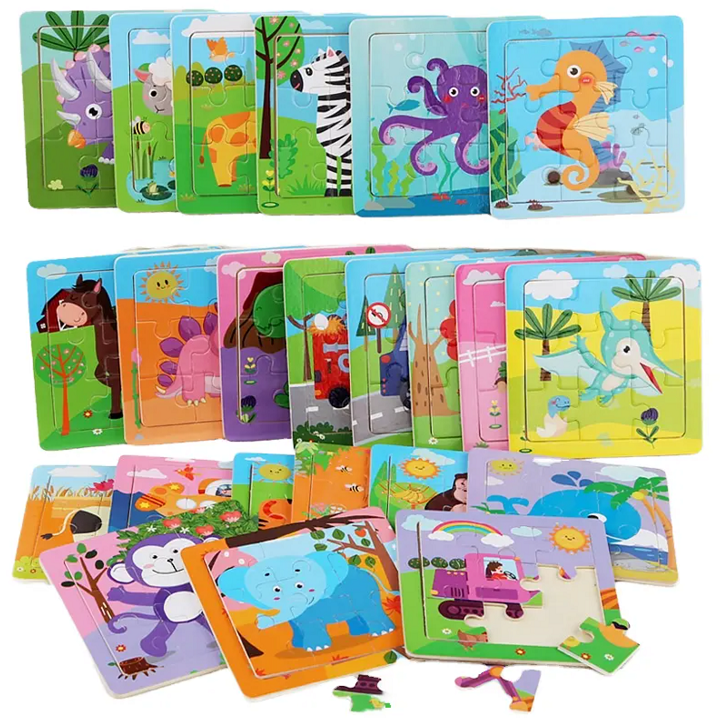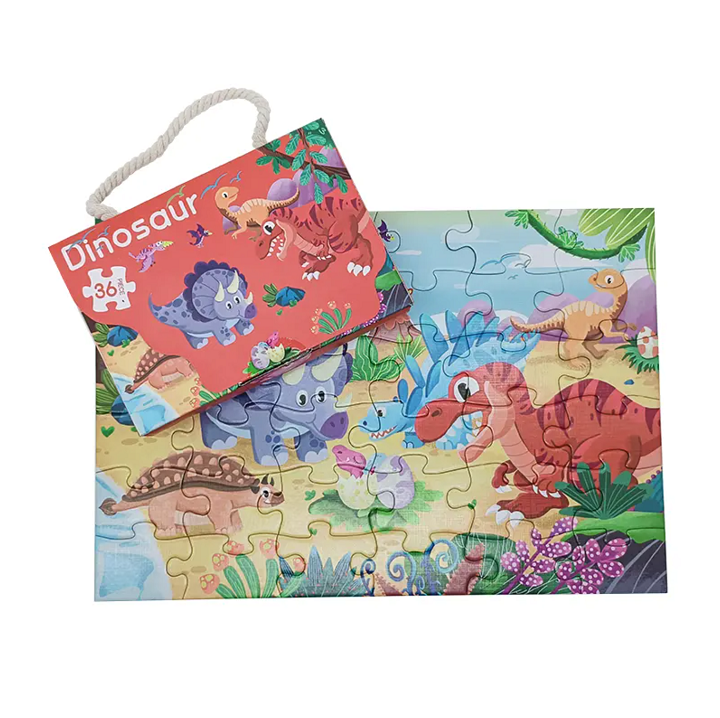Children's puzzles are more than just entertaining toys; they are vital educational tools that foster a child's cognitive, emotional, and social growth. From early infancy through preschool years, puzzles serve as engaging activities that promote essential skills, including problem-solving, fine motor coordination, language development, and social interaction. In this comprehensive exploration, we will delve into the various benefits of children's puzzles, the different types suitable for various ages, practical strategies for parents and educators, and the lasting impact they have on a child's development. Alongside detailed explanations, we include illustrative images to enhance understanding and engagement.

What Are Children's Puzzles?
Children's puzzles are structured activities or toys designed with interlocking or fitting pieces that, when assembled correctly, form a complete picture, shape, or pattern. They come in a wide range of formats, from simple shape sorters for infants to complex jigsaw puzzles for older children. The primary goal of puzzles is to challenge children to think critically, recognize patterns, and develop fine motor skills.
How Do Puzzles Benefit Children's Cognitive Development?
Enhancing Problem-Solving Skills
One of the most significant benefits of puzzles is their ability to develop problem-solving abilities. When children encounter a puzzle, they are faced with the task of figuring out how pieces fit together. This process involves analyzing shapes, colors, and patterns, which promotes logical thinking. As they experiment with different pieces, they learn to evaluate options, make decisions, and adapt strategies—skills that are fundamental to academic success and everyday life.
Improving Memory and Concentration
Working on puzzles requires children to remember the shapes, colors, and images associated with each piece. They also need to recall where certain pieces might fit based on previous attempts. This repetitive process strengthens working memory and enhances their ability to concentrate on complex tasks for extended periods. Over time, children become more adept at focusing, which benefits their performance in classroom activities and other learning environments.
Developing Spatial Awareness and Fine Motor Skills
Manipulating puzzle pieces helps children understand spatial relationships—how objects relate to each other in space. For example, fitting edge pieces or matching shapes fosters an understanding of boundaries and positioning. Additionally, grasping, turning, and precisely placing pieces refine fine motor skills and hand-eye coordination, which are essential for writing, drawing, and other daily activities.
What Emotional and Social Skills Do Puzzles Foster?
Patience and Perseverance
Completing a puzzle often involves trial and error, which teaches children patience and resilience. They learn that persistence leads to success, and they experience the satisfaction of overcoming challenges. This emotional resilience is crucial for handling setbacks in other areas of life.
Social Interaction and Teamwork
When children solve puzzles collaboratively, they practice communication, sharing, and cooperation. Working together encourages the development of social skills such as listening, negotiating, and respecting others’ ideas. Collaborative puzzles can also foster a sense of community and shared achievement.
Confidence and Independent Learning
Successfully completing a puzzle boosts a child's self-esteem and encourages independent exploration. They gain confidence in their abilities, which motivates them to tackle more complex tasks and fosters a growth mindset.

What Types of Puzzles Are Best for Different Age Groups?
Choosing age-appropriate puzzles is crucial to ensure children are challenged without becoming frustrated. Here is a helpful guide:
| Age Group | Puzzle Type | Developmental Focus |
| Babies (6-12 months) | Large-piece shape sorters, textured puzzles | Sensory exploration, early vocabulary, grasping skills |
| Toddlers (1-3 years) | Simple jigsaw puzzles, matching puzzles | Fine motor skills, object recognition, vocabulary development |
| Preschoolers (3-5 years) | More complex jigsaw puzzles, sequencing puzzles, thematic puzzles | Logical reasoning, storytelling, spatial awareness, early reading skills |
How Can Parents and Educators Use Puzzles Effectively?
Strategies for Babies and Toddlers
Encourage Exploration: For infants, simply removing large puzzle pieces from boards can promote grasping and motor skills. Naming each piece as they explore enhances vocabulary.
Matching and Sorting: Use puzzles that require matching shapes or pictures to develop visual recognition and categorization skills.
Sensory Engagement: Choose textured or multi-sensory puzzles to stimulate tactile exploration, which supports language development and sensory processing.
Strategies for Preschoolers
Thematic Learning: Use puzzles related to animals, habitats, or everyday objects to introduce new vocabulary and concepts.
Sequencing and Storytelling: Incorporate puzzles that require arranging images in a logical order, fostering understanding of sequences and narratives.
Problem-Solving Challenges: Present puzzles with more pieces or intricate designs to encourage strategic thinking, patience, and perseverance.
Incorporating Puzzles into Daily Learning
Set aside dedicated puzzle time as part of daily routines.
Use puzzles as a reward or a calming activity.
Encourage children to explain their reasoning, fostering language and cognitive skills.
What Are the Lasting Educational Values of Puzzles?
Puzzles contribute to a broad spectrum of lifelong skills:
Critical Thinking and Strategic Planning: Children learn to approach problems systematically.
Memory and Cognitive Flexibility: Exposure to various puzzle types encourages adaptable thinking.
Emotional Regulation: Children learn to manage frustration and celebrate successes, building resilience.
Social Skills: Collaborative puzzle solving promotes teamwork, empathy, and communication.
Academic Support: Puzzles support foundational skills in math, reading, and science by enhancing spatial reasoning, pattern recognition, and logical thinking.
Additional Benefits
Creativity and Imagination: Thematic puzzles inspire storytelling and creative thinking.
Cultural Awareness: Puzzles featuring diverse images promote inclusivity and cultural understanding.
Self-Directed Learning: Puzzles foster independence as children learn to set goals and achieve them.

Frequently Asked Questions About Children's Puzzles
Q1: At what age should I introduce puzzles to my child?
A1: Simple, large-piece puzzles can be introduced as early as 6 months. As children grow, gradually introduce more complex puzzles that match their developing skills, typically around 1-2 years for basic puzzles and 3+ for more challenging ones.
Q2: How do puzzles help with language development?
A2: Puzzles encourage children to name objects, describe images, and answer questions about the pictures, which expands vocabulary and enhances expressive language skills.
Q3: Can puzzles improve social skills?
A3: Absolutely. When children work together on puzzles, they practice sharing, turn-taking, communicating ideas, and cooperating, all of which are essential social skills.
Q4: What types of puzzles are best for preschoolers?
A4: Puzzles with 12-48 pieces, themed around animals, vehicles, or daily life, are ideal. Sequencing puzzles and those with educational themes support cognitive development.
Q5: How do puzzles support academic learning?
A5: Puzzles strengthen spatial reasoning, pattern recognition, logical thinking, and patience, laying a foundation for success in subjects like math, science, and literacy.
Conclusion
Children's puzzles are invaluable educational tools that promote a well-rounded development—cognitive, emotional, social, and academic. They provide a fun, engaging way for children to explore their environment, develop essential skills, and build confidence. Whether through simple shape sorters or complex jigsaw puzzles, the key is to select age-appropriate options and incorporate puzzle activities into daily routines. As children progress, puzzles continue to serve as powerful catalysts for learning, creativity, and resilience, shaping their readiness for future challenges.
































